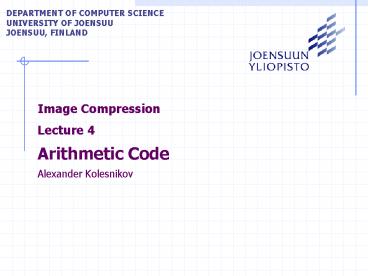Image Compression - PowerPoint PPT Presentation
1 / 20
Title: Image Compression
1
DEPARTMENT OF COMPUTER SCIENCE UNIVERSITY OF
JOENSUU JOENSUU, FINLAND
- Image Compression
- Lecture 4
- Arithmetic Code
- Alexander Kolesnikov
2
Arithmetic code
- Alphabet extension (blocking symbols) can lead to
coding efficiency - How about treating entire sequence as one symbol!
- Not practical with Huffman coding
- Arithmetic coding allows you to do precisely this
- Basic idea - map data sequences to sub-intervals
in 0,1) with lengths equal to probability of
corresponding sequence. - 1) Huffman coder H ? R ? H 1
bit/pel - 2) Block coder Hn ? Rn ? Hn 1/n
bit/pel - 3) Arithmetic code H ? R? ? H 1
bit/message (!)
3
Arithmetic code History
- Shannon 1948 a code string can be a binary
fraction - of pointing to the
subinterval - but Huffman code appeared ...
- Ellias 1963 successive subdivision of the
interval - -gt development of Golomb-Rice codes
- Chalkwijk 1972, Cover 1973
- Rissanen 1976 arithmetic code
- Pasco 1976 arithmetic code
4
Arithmetic code Algorithm (1)
0) Start by defining the current interval as
0,1). 1) REPEAT for each symbol s in the input
stream a) Divide the current interval L, H)
into subintervals whose sizes are
proportional to the symbols's
probabilities. b) Select the subinterval L,
H) for the symbol s and define it as the
new current interval 2) When the entire input
stream has been processed, the output should
be any number V that uniquely identify the
current interval L, H).
5
Arithmetic code Algorithm (2)
0.70
6
Arithmetic codeAlgorithm (3)
Probabilities p1, p2, , pN. Cumulants C10
C2C1p1p1 C3C2p2 p1p2 etc.
CNp1p2pN-1 CN11 0) Current interval
L, H) 0.0, 1.0) 1) REPEAT for each symbol
si in the input stream H ? L (H ?
L)C(si1), L ? L (H ? L)C(si) 2)
UNTIL the entire input stream has been
processed. The output code V is any number
that uniquely identify the current interval
L, H).
7
Example 1 Statistics
Message 'SWISS_MISS' Char Freq Prob
C(si), C(si1)) S 5 5/100.5 0.5,
1.0) W 1 1/100.1 0.4, 0.5) I 2 2/100.2 0.2
, 0.4) M 1 1/100.1 0.1, 0.2) _ 1 1/100.1 0
.0, 0.1)
8
Example 1 Encoding
S 0.5 0.5, 1.0) W 0.1 0.4, 0.5) I
0.2 0.2, 0.4) M 0.1 0.1, 0.2) __ 0.1
0.0, 0.1)
9
Example 1 Decoding
V ? 0.71753375, 0.71753500)
S 0.5 0.5, 1.0) W 0.1 0.4, 0.5) I
0.2 0.2, 0.4) M 0.1 0.1, 0.2) __ 0.1
0.0, 0.1)
10
Example 1 Compression?
- V ? 0.71753375, 0.71753500)
- How many bits do we need to encode a number V
- in the final interval L, H)?
0 1
00 01
10 11
000 001
010 011
101 101
110 111
0000 0001
1110 1111
1
0
- m4 bits 1624 intervals of size ?1/16.
- The number of bits m to represent a value in the
interval - of size ? m ?-Log2(?)? bits.
11
Example 1 Compression (1)
- V ? L, H) 0.71753375, 0.71753500)
- Interval size (range) r
- r0.50.10.20.50.50.10.10.20.50.50.0000
0125 - The number of bits to represent a value in the
- interval L, H)L, Lr) of size r
- m?-log2r? ?-log2(0.0000125)? ?19.6? 20
bits
12
Example 1 Compression (2)
- Entropy 1.96 bits/char
- Arithmetic coder
- a) Codeword V L ? V ? H
- V (0.71753407)10 (0.1011011110110000010
1)2 - ... 20 bits ...
- 0.71753375 ? 0.71753407 ? 0.71753500
- b) Codelength m
- m?-log2(r)? ?-log2(0.0000125)? ?19.6?
20 bits - c) Bitrate R20 bits/10 chars 2.0 bits/char
- Huffman coder (1321144211)/102.2
bits/char
13
Example 2 EOF (1)
Binary alphabet pa0.999, pb0.001. Message
Lower end L 0 (!) Range r(H-L)
(pa)10003.710-4 ?11.41?12 bits
0 ? V ? H Codeword V (0)10(0)2
(!)
14
Example 2 EOF (2)
Alphabet pa0.998, pb0.001, pEOF0.001. Message
Lower end L pEOF 0.001 HL1.3510-4
0.00135 Range r(H-L) (pa)1000pEOF
1.3510-4 0.001 ? V ?
0.001135 m?-log2((0.998)1000(0.001))??12.85?13
bits Code length 13 bits Code
V(0.0000000001001)2 2-10 2-12 0.0011...
Bitrate R13 bits /1000 pels 0.013
bits/pel Huffman code 1000 bits/data or 1.0
bit/pixel
15
Problem of practical implemention
- Input filesize 1 Mbyte
- Compressed filesize 100 Kbytes
- Size of codeword is 100 Kbytes?
- How to perform calculation for arithmetic coder?
16
AC Implementation with shifting
1) Scaled LH L?L10000 H?H10000-1 2)
New LH Push the digit and shift left
(?10)
In practice the binary arithmetic is in use!
17
Binary arithmetic code Q-Coder
LPS (less probable symbol) pLPSQ MPS (more
probable symbol) pMPS1-Q
si MPS LPS r ? r(1-Q)
?R-Q rQ ?Q L ? L
Lr(1-Q) ?Lr-Q
HLr
Qr
Lr(1-Q)
r(1-Q)
Keep 0.75 ? r ? 1.5 !
a) r ? r-Q or Q Encoding b) r ? 2r
Renormalization
L
18
Binary arithmetic code Renormalization
Out 1 Out 0
Out 01 or 10
Two renormalizations
19
Properties of arithmetic code
- In practice, for images, arithmetic coding gives
15-30 improvement in compression ratios over a
simple Huffman coder. The complexity of
arithmetic coding is however 50-300 higher.
20
Contents
- Arithmetic code
- Implementation details































